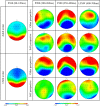Age of avatar modulates the altercentric bias in a visual perspective-taking task: ERP and behavioral evidence
- PMID: 30242574
- PMCID: PMC6244738
- DOI: 10.3758/s13415-018-0641-1
Age of avatar modulates the altercentric bias in a visual perspective-taking task: ERP and behavioral evidence
Abstract
Despite being able to rapidly and accurately infer their own and other peoples' visual perspectives, healthy adults experience difficulty ignoring the irrelevant perspective when the two perspectives are in conflict; they experience egocentric and altercentric interference. We examine for the first time how the age of an observed person (adult vs. child avatar) influences adults' visual perspective-taking, particularly the degree to which they experience interference from their own or the other person's perspective. Participants completed the avatar visual perspective-taking task, in which they verified the number of discs in a visual scene according to either their own or an on-screen avatar's perspective (Experiments 1 and 2) or only from their own perspective (Experiment 3), where the two perspectives could be consistent or in conflict. Age of avatar was manipulated between (Experiment 1) or within (Experiments 2 and 3) participants, and interference was assessed using behavioral (Experiments 1-3) and ERP (Experiment 1) measures. Results revealed that altercentric interference is reduced or eliminated when a child avatar was present, suggesting that adults do not automatically compute a child avatar's perspective. We attribute this pattern to either enhanced visual processing for own-age others or an inference on reduced mental awareness in younger children. The findings argue against a purely attentional basis for the altercentric effect, and instead support an account where both mentalising and directional processes modulate automatic visual perspective-taking, and perspective-taking effects are strongly influenced by experimental context.
Keywords: Altercentric interference; ERPs; Self/other; Theory of Mind; Visual perspective-taking.
Figures









Similar articles
-
Eye tracking reveals the cost of switching between self and other perspectives in a visual perspective-taking task.Q J Exp Psychol (Hove). 2017 Aug;70(8):1646-1660. doi: 10.1080/17470218.2016.1199716. Epub 2016 Jun 30. Q J Exp Psychol (Hove). 2017. PMID: 27364567
-
Does altercentric interference rely on mentalizing?: Results from two level-1 perspective-taking tasks.PLoS One. 2018 Mar 22;13(3):e0194101. doi: 10.1371/journal.pone.0194101. eCollection 2018. PLoS One. 2018. PMID: 29566019 Free PMC article.
-
Altercentric interference in level 1 visual perspective taking reflects the ascription of mental states, not submentalizing.J Exp Psychol Hum Percept Perform. 2016 Feb;42(2):158-63. doi: 10.1037/xhp0000138. Epub 2015 Sep 21. J Exp Psychol Hum Percept Perform. 2016. PMID: 26389611
-
Perspective Taking and Avatar-Self Merging.Front Psychol. 2022 Mar 18;13:714464. doi: 10.3389/fpsyg.2022.714464. eCollection 2022. Front Psychol. 2022. PMID: 35369185 Free PMC article. Review.
-
The closing of the theory of mind: A critique of perspective-taking.Psychon Bull Rev. 2019 Dec;26(6):1787-1802. doi: 10.3758/s13423-019-01657-y. Psychon Bull Rev. 2019. PMID: 31515733 Review.
Cited by
-
Taking the perspectives of many people: Humanization matters.Psychon Bull Rev. 2021 Jun;28(3):888-897. doi: 10.3758/s13423-020-01850-4. Epub 2020 Dec 14. Psychon Bull Rev. 2021. PMID: 33319316 Free PMC article.
-
The influence of in-groups and out-groups on the theory-of-mind processing: evidence from different ethnic college students.Cogn Res Princ Implic. 2023 Jan 24;8(1):5. doi: 10.1186/s41235-023-00461-6. Cogn Res Princ Implic. 2023. PMID: 36690778 Free PMC article.
-
Neural empathy mechanisms are shared for physical and social pain, and increase from adolescence to older adulthood.Soc Cogn Affect Neurosci. 2024 Dec 5;19(1):nsae080. doi: 10.1093/scan/nsae080. Soc Cogn Affect Neurosci. 2024. PMID: 39492751 Free PMC article.
-
Tracking developmental differences in real-world social attention across adolescence, young adulthood and older adulthood.Nat Hum Behav. 2021 Oct;5(10):1381-1390. doi: 10.1038/s41562-021-01113-9. Epub 2021 May 13. Nat Hum Behav. 2021. PMID: 33986520 Free PMC article.
-
Visual perspective-taking in complex natural scenes.Q J Exp Psychol (Hove). 2022 Aug;75(8):1541-1551. doi: 10.1177/17470218211054474. Epub 2021 Oct 25. Q J Exp Psychol (Hove). 2022. PMID: 34615389 Free PMC article.
References
-
- Bailey PE, Slessor G, Rendell PG, Bennetts RJ, Campbell A, Ruffman T. Age differences in conscious versus subconscious social perception: The influence of face age and valence on gaze following. Psychology and Aging. 2014;29(3):491–502. - PubMed
-
- Baron-Cohen S, Wheelwright S. The empathy quotient: An investigation of adults with Asperger syndrome or high functioning autism and normal sex differences. Journal of Autism and Developmental Disorders. 2004;34:163–75. - PubMed
-
- Blakemore SJ. The social brain in adolescence. Nature Reviews Neuroscience. 2008;9(4):267–277. - PubMed
-
- Borji A, Parks D, Itti L. Complementary effects of gaze direction and early saliency in guiding fixations during free viewing. Journal of Vision. 2014;14(13):3. - PubMed
-
- Bradford EE, Jentzsch I, Gomez JC. From self to social cognition: Theory of mind mechanisms and their relation to executive functioning. Cognition. 2015;138:21–34. - PubMed
Publication types
MeSH terms
LinkOut - more resources
Full Text Sources
Other Literature Sources

